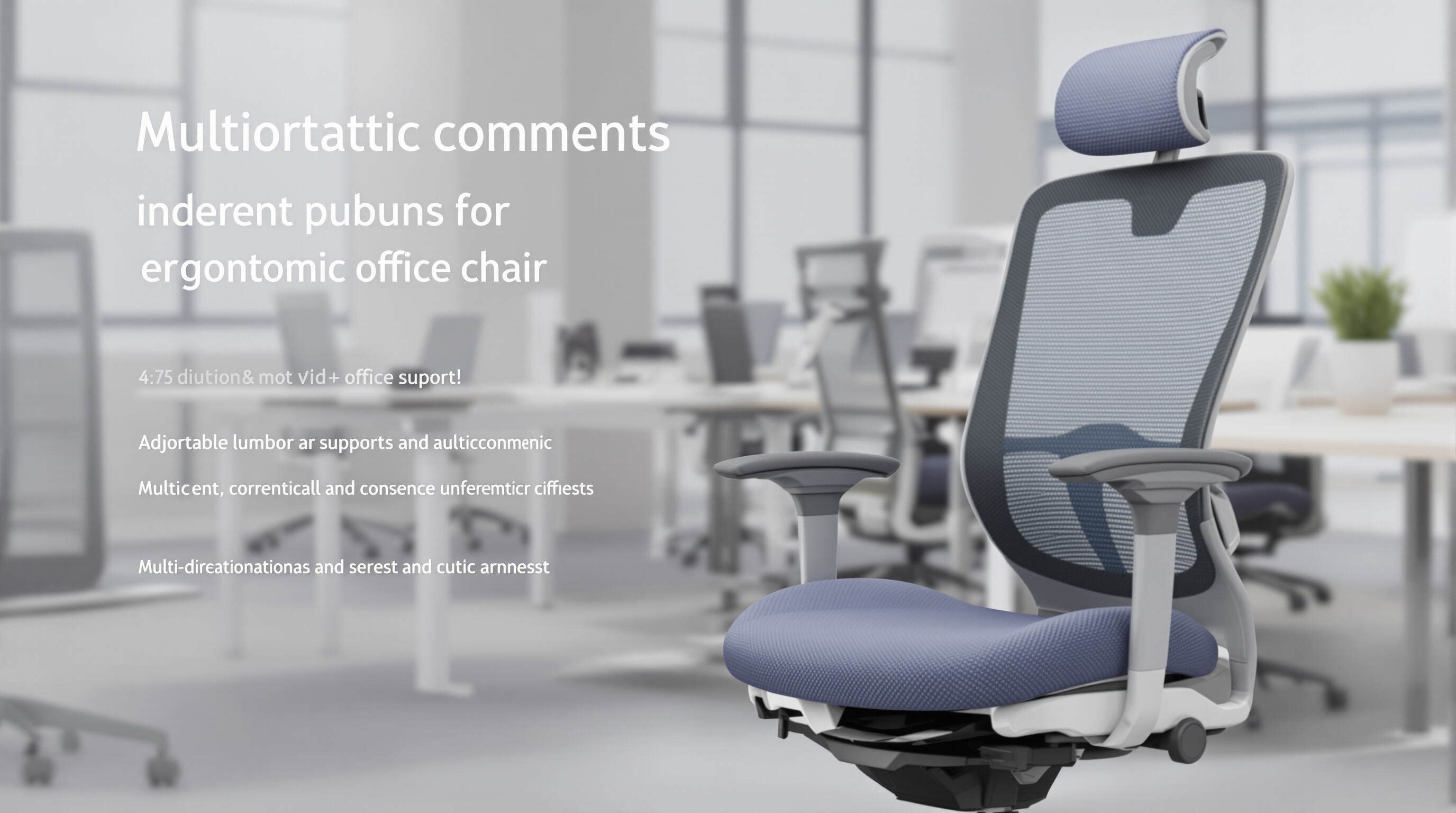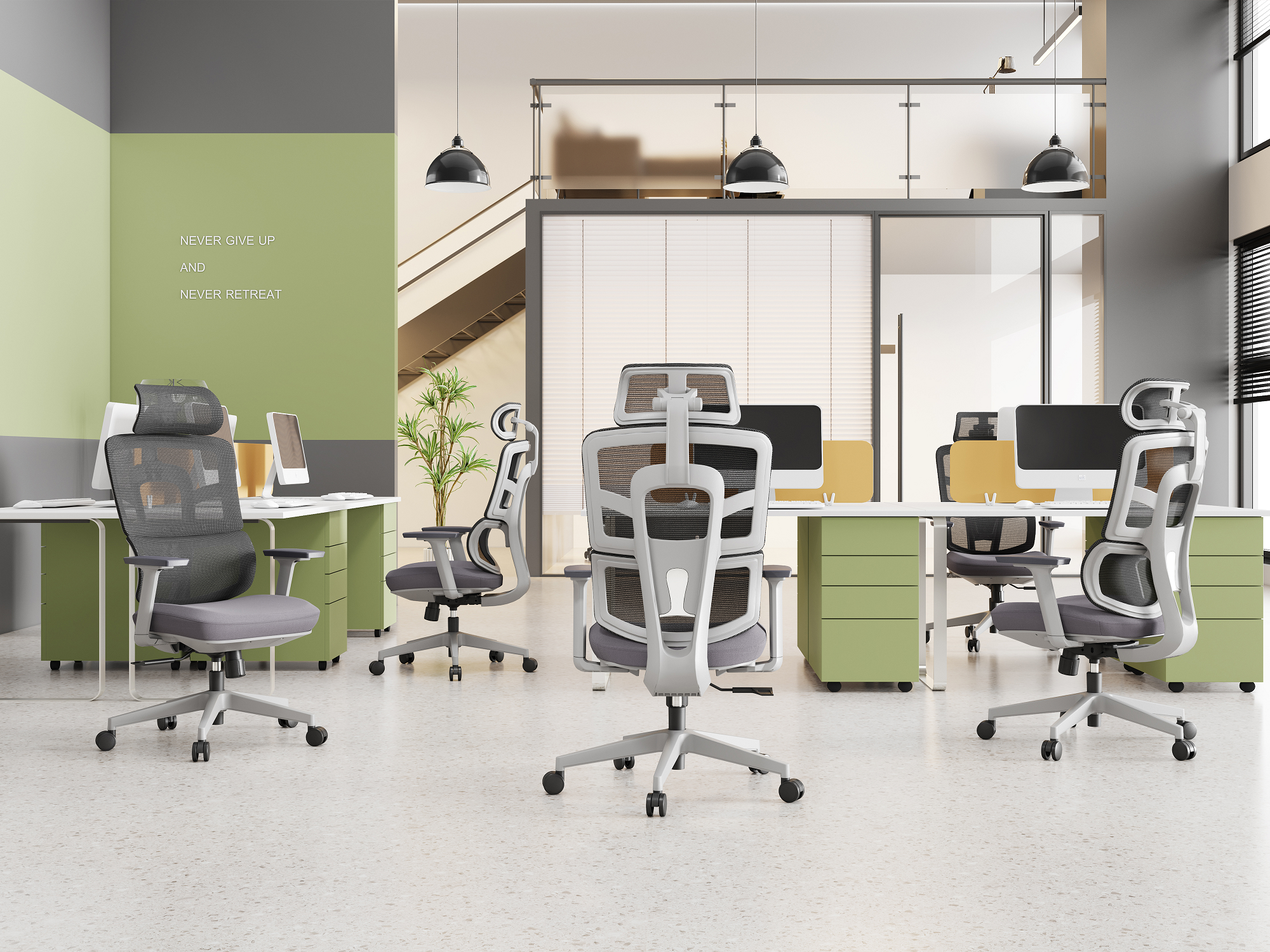Understanding Ergonomic Office Chairs and Their Role in Workplace Health
Defining "Ergonomic Office Chairs" in the Context of Modern Workplace Design
Ergonomic office chairs aren't just regular seats but special designs meant to match how our bodies naturally move and sit. What makes them different from old school chairs is all the adjustments they offer. Most people can change the height, depth, and even how much the chair tilts forward or backward. This helps folks of all shapes and sizes find a comfortable position. When someone sits properly in one of these chairs, their back stays straight, shoulders don't hunch forward, and feet rest flat on the floor without dangling. That makes a big difference after hours at the computer. Many newer models come with mesh backs that let air circulate better, plus built-in support for the lower back area. Companies have started making these features standard because employees who stay healthier tend to be more productive overall.
The Science Behind Ergonomics and Its Impact on Musculoskeletal Health
The field of ergonomics takes what we know about body mechanics and uses it to make workspaces better for people. Research published in the Journal of Occupational Health last year found something pretty alarming: sitting in badly designed chairs can raise the chance of developing lower back pain by almost half. When someone stays in one position too long, those little discs between the vertebrae get squished, and the muscles that normally support the spine start to tire out. Good quality ergonomic seating actually spreads the weight across different parts of the body instead of concentrating it all on spots like the tailbone or shoulders. These chairs are designed so workers move around just enough while sitting, keeping blood flowing and muscles engaged rather than going numb. And this kind of active support makes a big difference in preventing long term problems like slipped discs or that nagging tension people often feel in their necks and shoulders after a day at the desk.
How Proper Posture Supported by Ergonomic Seating Prevents Long-Term Injuries
Spending too much time hunched over in stiff office chairs can really take a toll on our backs and lead to all sorts of problems down the road. That's where ergonomic seating comes in handy. These special chairs come equipped with adjustable back supports that keep the spine aligned properly in its natural curve shape, so people don't end up slumping forward all day long. The seat itself often has those rounded front edges that actually take some weight off the thighs and away from sensitive nerve areas. Plus there are those fancy four dimensional armrests that let workers position their arms comfortably at about a right angle, which helps protect against shoulder pain. Combine all these design elements with regular get-up-and-move moments throughout the workday, and we're looking at significantly reduced risks of developing sciatica or hand issues like carpal tunnel. For anyone who spends most of their day sitting at a desk, investing in good chair ergonomics makes sense both medically and practically speaking.
Key Features of Ergonomic Office Chairs That Enhance Comfort and Support

Modern ergonomic office chairs integrate scientifically validated features to reduce discomfort and injury risk while enhancing productivity through better biomechanical alignment.
Adjustable Lumbar Support and Its Role in Spinal Alignment
Adaptive lumbar systems maintain the spine's natural S-curve, reducing slouching during extended sitting. By conforming to the lower backâs contour, they minimize disc pressureâa key factor in preventing chronic lower back pain.
Customizable Seat Dimensions for Optimal Posture and Circulation
Research cited by ergonomic design experts confirms that adjustable seat depth and height prevent leg numbness by ensuring proper thigh alignment. These adjustments enable users to keep feet flat and knees at a 90-degree angle, promoting healthy circulation across diverse body types.
5D Adjustable Armrests to Minimize Upper-Body Strain
Multi-directional armrests adapt to individual elbow height, width, and angle, reducing shoulder and neck tension during typing. This full-range adjustability helps prevent repetitive strain in wrists and forearms, especially during long computing sessions.
Breathable Mesh Fabric for Sustained Comfort During Extended Use
High-tension mesh enhances airflow and evenly distributes body weight across the seat. Unlike foam cushions that degrade over time, mesh prevents heat buildup and maintains structural support throughout an 8-hour workday.
The Impact of Ergonomic Office Chairs on Posture and Long-Term Health
How Seat Height and Depth Adjustments Promote Correct Sitting Posture
Correct seat height ensures hips are level with or slightly above the knees, allowing feet to rest flat and maintaining spinal neutrality. Depth adjustments support 80â90% of thigh length without pressing behind the knees, reducing forward slouching and uneven load on lumbar discs and hip flexors.
Lumbar Support and the Maintenance of Natural Spinal Curvature
Adjustable lumbar systems fill the gap between the lower back and seatback, preserving the spineâs natural S-shape. This support reduces disc pressure by up to 40% during prolonged sitting and prevents ligament overstretchingâa common precursor to herniated discs.
Case Study: Posture Improvement Among Remote Workers Using Ergonomic Seating
A 2023 study of 200 remote employees found a 57% reduction in reported slouching after six months of using ergonomic chairs. Those with 4D armrests and dynamic recline mechanisms showed a 32% improvement in cervical spine alignment compared to peers using standard office seating.
Reducing Chronic Back Pain and Circulation Issues Through Consistent Ergonomic Use
Ergonomic chairs promote micro-movements via tilt mechanisms, enhancing blood flow to the legs and reducing extremity fatigue. Users report a 48% decrease in lower back pain severity within three months. Breathable mesh further mitigates heat retention, which is linked to circulatory issues and swelling in sedentary environments.
Boosting Productivity and Focus with Ergonomic Seating Solutions
Measuring the link between seating comfort and employee concentration
Employees using ergonomic office chairs experience 42% fewer posture-related distractions than those in traditional seating (Ergonomics International 2023). Features like adjustable lumbar support and breathable materials reduce frequent position shifts by 63%, enabling 28% longer focus periods during demanding cognitive tasks.
Data insight: Up to 17% increase in focus after transitioning to ergonomic chairs
Organizations report a 17.7% improvement in attention span during four-hour work blocks after adopting ergonomic seating (OfficeLogix 2024). Employees using chairs with 5D armrests complete data-intensive tasks 19% faster and make 31% fewer errors, highlighting the direct cognitive benefits of physical comfort.
Trend analysis: Rising adoption of ergonomic furniture in tech and hybrid workplaces
Seventy-eight percent of U.S. tech firms now include ergonomic seating in remote work stipends, recognizing its impact on engagement and performance. Hybrid workplaces using ergonomic solutions report 40% fewer sick days due to musculoskeletal issues, contributing to a 12% rise in quarterly project completion rates.
Economic Benefits for Organizations Investing in Ergonomic Office Chairs
Companies actually see real money saved when they invest in good ergonomic chairs, not just better employee comfort. Recent research from 2023 shows businesses get about $9 back for every dollar invested in these programs, mostly because people miss work less often and medical bills drop. The Bureau of Labor Statistics tells us that around one third of all workplace disability claims come from muscle and bone injuries, so having chairs with adjustable back support makes a big difference in preventing those kinds of problems. Take a midsize business with 100 employees as an example. With proper seating solutions in place, they could avoid roughly 290 days of lost work each year, which means saving close to $50,000 worth of productivity that would otherwise vanish into the ether.
Cost-benefit analysis: Lower absenteeism and reduced healthcare costs
Ergonomic seating reduces lower back pain incidence by 44%, cutting annual per-employee healthcare expenses by $870 (Occupational Medicine Journal 2023). Workers using adjustable chairs take 21% fewer unplanned sick days, directly reducing reliance on overtime and temporary labor.
Long-term ROI of ergonomic furniture in improving employee retention and satisfaction
According to a 2023 Workplace Wellness Report, 68% of employees consider ergonomic support important when evaluating job offers. Companies investing in ergonomic chairs see 27% lower turnover, saving $37,000 per retained employee in recruitment and onboarding. Enhanced comfort and posture also correlate with 19% higher job satisfaction, reinforcing loyalty, engagement, and sustained performance.
FAQs About Ergonomic Office Chairs
What makes an office chair ergonomic?
An ergonomic office chair is designed to support the user's body by allowing multiple adjustments that promote healthy posture and biomechanics, such as adjustable seat height, depth, lumbar support, and armrests.
How do ergonomic chairs prevent back pain?
Ergonomic chairs help distribute weight more evenly across the user's body, reducing pressure on the spine and supporting the natural S-curve, thus reducing the risk of developing lower back pain.
What are some key features to look for in an ergonomic chair?
Important features to consider include adjustable lumbar support, seat depth and height adjustments, 5D adjustable armrests, and breathable mesh fabric for comfort during long hours of use.
How do ergonomic chairs contribute to increased productivity?
By minimizing posture-related distractions and enabling prolonged concentration periods, ergonomic chairs enhance focus and cognitive performance, leading to greater productivity.
Table of Contents
- Understanding Ergonomic Office Chairs and Their Role in Workplace Health
- Key Features of Ergonomic Office Chairs That Enhance Comfort and Support
- The Impact of Ergonomic Office Chairs on Posture and Long-Term Health
- Boosting Productivity and Focus with Ergonomic Seating Solutions
- Economic Benefits for Organizations Investing in Ergonomic Office Chairs
- FAQs About Ergonomic Office Chairs

